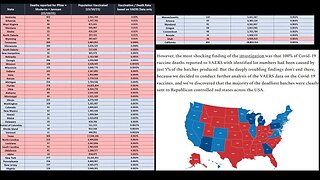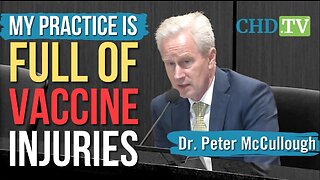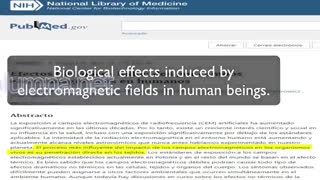<WARNING FACTS> - Covid, Election, Vaccines, Jan-6th And More...
PCR (polymerase chain reaction) is a method to analyze a short sequence of DNA (or RNA) even in samples containing only minute quantities of DNA or RNA. PCR is used to reproduce (amplify) selected sections of DNA or RNA.
Pfizer-BioNTech C O VID-19 Vaccine may not protect all vaccine recipients.
Adverse reactions following the Pfizer-BioNTech C O VID-19 Vaccine that have been reported in clinical trials include injection site pain, fatigue, headache, muscle pain, chills, joint pain, fever, injection site swelling, injection site redness, nausea, malaise, and lymphadenopathy (see Full EUA Prescribing Information). Severe allergic reactions have been reported following the Pfizer-BioNTech C O VID-19 Vaccine during mass vaccination outside of clinical trials. Additional adverse reactions, some of which may be serious, may become apparent with more widespread use of the Pfizer-BioNTech C O VID-19 Vaccine.
The Secretary of Health and Human Services (HHS) has declared a public health emergency that justifies the emergency use of drugs and biological products during the COVID-19 pandemic. In response, FDA has issued an EUA for the unapproved product, Pfizer-BioNTech C O VID-19 Vaccine, for active immunization against C O VID-19 in individuals 16 years of age and older.FDA issued this EUA, based on Pfizer-BioNTech’s request and submitted data.Although limited scientific information is available, based on the totality of the scientific evidence available to date, it is reasonable to believe that the Pfizer-BioNTech C O VID-19 Vaccine may be effective for the prevention of C O VID-19 in individuals as specified in the Full EUA Prescribing Information. This EUA for the Pfizer-BioNTech C O VID-19 Vaccine will end when the Secretary of HHS determines that the circumstances justifying the EUA no longer exist or when there is a change in the approval status of the product such that an EUA is no longer needed.
https://www.fda.gov/media/144413/download
The Elections Clause of the Constitution, Art. I, § 4, cl. 1, provides that “[t]he Times, Places and Manner of holding Elections for Senators and Representatives, shall be prescribed in each State by the Legislature thereof; but the Congress may at any time by Law make or alter such Regulations.” The Clause is a default provision; it invests the States with responsibility for the mechanics of congressional elections, see Storer v. Brown, 415 U. S. 724, 730 (1974), but only so far as Congress declines to pre-empt state legislative choices, see Roudebush v. Hartke, 405 U. S. 15, 24 (1972) (“Unless Congress acts, Art. I, § 4, empowers the States to regulate”). Thus it is well settled that the Elections Clause grants Congress “the power to override state regulations” by establishing uniform rules for federal elections, binding on the States. U. S. Term Limits, Inc. v. Thornton, 514 U. S. 779, 832-833 (1995). “[T]he regulations made by Congress are paramount to those made by the State legislature; and if they conflict therewith, the latter, so far as the conflict extends, ceases to be operative.” Ex parte Siebold, 100 U. S. 371, 384 (1880).
-
 1:00
1:00
ConventionOfStatesNevada
1 year agoCDC Votes 15-0 to add Covid-19 immunization to schools requirements 😟
62 -
 13:20
13:20
(NurembergTrials.net)
1 year agoSEN RENNICK WARNS AU ON COVID VAXX INJURIES, EXCESS DEATH & GOV DISINFORMATION (NUREMBERGTRIALS.NET)
519 -
 5:14
5:14
Truths Unlimited
1 year agoCDC Confirms - Majority of FATAL COVID VACCINES Were Knowingly Sent to Red States ~ Reese Report
3.08K2 -
 2:08
2:08
(NurembergTrials.net)
1 year agoFDA WARNINGS ON-THE-BOX OF COVID PCR TESTS DEBUNK GERM THEORY & VIROLOGY PT3 (NUREMBERGTRIALS.NET)
745 -
 12:37
12:37
InnerLight
1 year agoNew study: nearly everyone is getting heart damage from the COVID vaccines - October 18, 2022
238 -
 3:16
3:16
Vigilant News Network
3 months agoBad News for COVID Vaccine Manufacturers
3.37K6 -
 13:04
13:04
UTubekookdetector
10 months agoFact-checking USA Today's disingenuous defense of Anthony Fauci (COVID-19 vaccines)
3474 -
 1:22
1:22
USAFrontlineDoctors
1 year agoDr. McCullough Testifies the Truth About the Number of People Who Died from COVID Vaccines
1.2K1 -
 10:38
10:38
nonvaxer420
1 year agoBreaking News: SHOCKING - Here is What Really is in the " Covid-19 Vaccines"
8.45K79 -
 9:54
9:54
Asher Press
1 year ago"7.7 percent of 10 million V-safe users reported needing medical care after a COVID-19 vaccine.” - Aaron Siri Part 1
8651